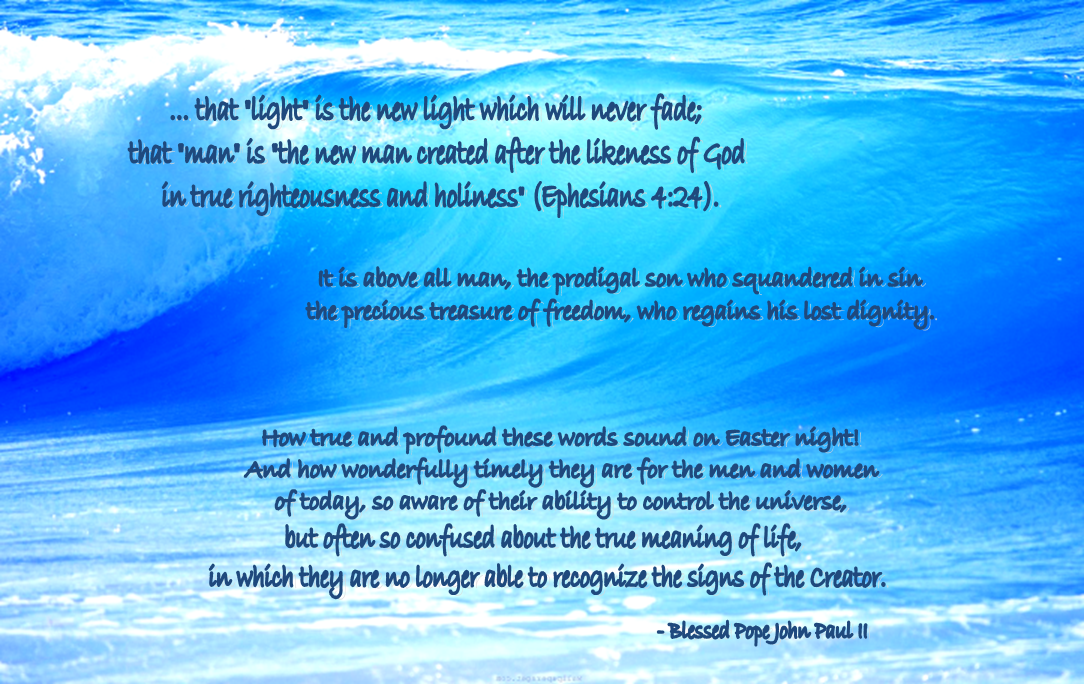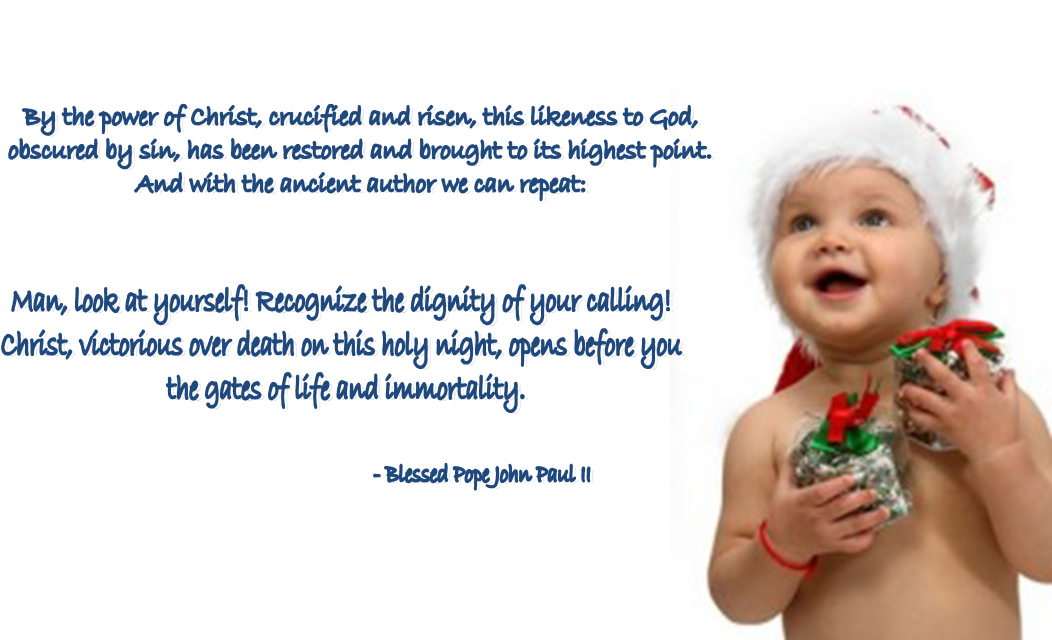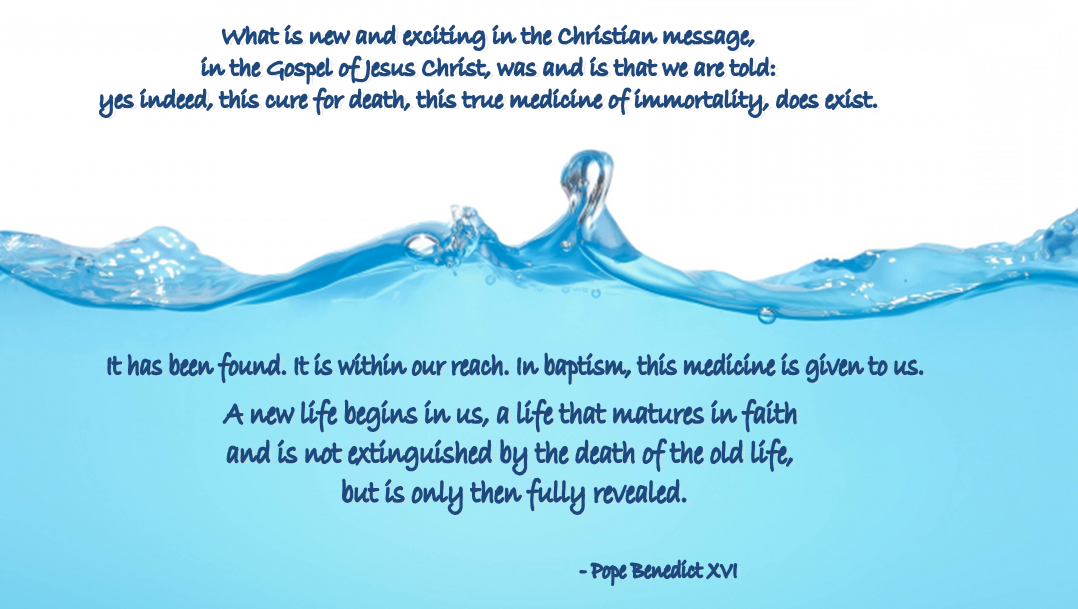
|
EASTER VIGIL HOMILY OF HIS HOLINESS POPE JOHN PAUL II Holy Saturday, 11 April 1998
1. "Let us make man in our image, after our likeness" (Genesis 1:26). "God created man in his own image, in the image of God he created him; male and female he created them" (Genesis 1:27).
In this Easter Vigil, the Liturgy proclaims the first chapter of the Book of Genesis, which recalls the mystery of creation and, in particular, the creation of man. Once more our attention centres on the mystery of man, the mystery made fully manifest in Christ and through Christ.
"Fiat lux", "faciamus hominem": these words of Genesis disclose their full truth when they are passed through the crucible of the Passover of the Word (cf. Psalm 12:6). During the quiet of Holy Saturday, through the silence of the Word, they find their fullest meaning: that "light" is the new light which will never fade; that "man" is "the new man created after the likeness of God in true righteousness and holiness" (Ephesians 4:24).
The new creation comes about at Easter. In the mystery of Christ's death and resurrection all is redeemed, and everything becomes once more perfectly good, according to God's original plan. It is above all man, the prodigal son who squandered in sin the precious treasure of freedom, who regains his lost dignity. "Faciamus hominem ad imaginem et similitudinem nostram". How true and profound these words sound on Easter night! And how wonderfully timely they are for the men and women of today, so aware of their ability to control the universe, but often so confused about the true meaning of life, in which they are no longer able to recognize the signs of the Creator.
2. In this regard, I am reminded of certain passages of the Constitution Gaudium et Spes of the Second Vatican Council, which blend harmoniously with the marvellous symphony of the Readings of the Easter Vigil. In fact, this Council document, if carefully studied, proves to be profoundly Paschal in both its content and its guiding inspiration. In it we read: "Only in the mystery of the incarnate Word does the mystery of man take on light. For Adam, the first man, was a figure of him who was to come (cf. Romans 5:14), namely, Christ the Lord. Christ ... is 'the image of the invisible God' (Colossians 1:15). He himself is the perfect man. To the sons of Adam he restores the divine likeness which had been disfigured from the first sin onward . . . By his incarnation the Son of God has united himself in some fashion with every man. By suffering for us he not only provides us with an example for our imitation. He blazed a trail, and if we follow it, life and death are made holy and take on a new meaning. The Christian man, conformed to the likeness of that Son who is the firstborn of many brothers, receives 'the first-fruits of the Spirit' (Romans 8:23) . . . Through this Spirit who is 'the pledge of our inheritance' (Ephesians 1:14), the whole man is renewed from within, even to the achievement of the 'redemption of the body' (Romans 8:23): 'If the Spirit of him who raised Jesus from the dead dwells in you, then he who raised Jesus from the dead will also bring to life your mortal bodies, because of his Spirit who dwells in you' (Romans 8:21). The Christian . . . linked with the Paschal mystery and patterned on the dying Christ, will hasten forward to resurrection in the strength which comes from hope" (No. 22).
3. These words of the recent Council present to us once more the mystery of the vocation of every baptized person. They present it in a particular way to you, dear Catechumens, who, according to the Church's very ancient tradition, will receive Holy Baptism in the course of this holy Vigil. We greet you with affection and we thank you for your witness.
You come from different nations throughout the world: Canada, China, Colombia, India, Italy, Poland, South Africa.
Dear friends, in a very special sense Baptism constitutes your Passover, the sacrament of your redemption, of your new birth in Christ through faith and the power of the Holy Spirit, by virtue of which you will be able to call God by the name of "Father" and will yourselves be children in the Son.
We express the hope that the new life which you will receive as a gift this most holy night will grow to its fullest, bringing abundant fruits of love, joy and peace, the fruits of eternal life. |

|
4. "O vere beata nox!", the Church sings in the Paschal Exsultet, recalling the great works of God wrought in the Old Testament during the exodus of the Israelites from Egypt. This is the prophetic announcement of the exodus of the human race from the slavery of death to new life through Christ's Passover.
O vere beata nox!, we repeat with the Easter hymn, contemplating the universal mystery of man in the light of Christ's Resurrection. In the beginning God created man in his own image and likeness. By the power of Christ, crucified and risen, this likeness to God, obscured by sin, has been restored and brought to its highest point. And with the ancient author we can repeat: Man, look at yourself! Recognize the dignity of your calling! Christ, victorious over death on this holy night, opens before you the gates of life and immortality.
Echoing the words sung by the deacon in the Easter proclamation, I repeat with joy: Annuntio vobis gaudium magnum: surrexit Dominus vere! Surrexit hodie! Amen!
Acknowledgment: We thank the Vatican Publisher for allowing us to publish the Homily of Blessed Pope John Paul II, so that it could be accessed by more people all over the world; as a source of God’s encouragements to all of us.
HOMILY OF HIS HOLINESS BENEDICT XVI Saint Peter's Basilica (Video)
Dear Brothers and Sisters,
An ancient Jewish legend from the apocryphal book “The life of Adam and Eve” recounts that, in his final illness, Adam sent his son Seth together with Eve into the region of Paradise to fetch the oil of mercy, so that he could be anointed with it and healed. The two of them went in search of the tree of life, and after much praying and weeping on their part, the Archangel Michael appeared to them, and told them they would not obtain the oil of the tree of mercy and that Adam would have to die. Later, Christian readers added a word of consolation to the Archangel’s message, to the effect that after 5,500 years the loving King, Christ, would come, the Son of God who would anoint all those who believe in him with the oil of his mercy. “The oil of mercy from eternity to eternity will be given to those who are reborn of water and the Holy Spirit. Then the Son of God, Christ, abounding in love, will descend into the depths of the earth and will lead your father into Paradise, to the tree of mercy.” This legend lays bare the whole of humanity’s anguish at the destiny of illness, pain and death that has been imposed upon us. Man’s resistance to death becomes evident: somewhere – people have constantly thought – there must be some cure for death. Sooner or later it should be possible to find the remedy not only for this or that illness, but for our ultimate destiny – for death itself. Surely the medicine of immortality must exist. Today too, the search for a source of healing continues. Modern medical science strives, if not exactly to exclude death, at least to eliminate as many as possible of its causes, to postpone it further and further, to prolong life more and more. But let us reflect for a moment: what would it really be like if we were to succeed, perhaps not in excluding death totally, but in postponing it indefinitely, in reaching an age of several hundred years? Would that be a good thing? Humanity would become extraordinarily old, there would be no more room for youth. Capacity for innovation would die, and endless life would be no paradise, if anything a condemnation. The true cure for death must be different. It cannot lead simply to an indefinite prolongation of this current life. It would have to transform our lives from within. It would need to create a new life within us, truly fit for eternity: it would need to transform us in such a way as not to come to an end with death, but only then to begin in fullness. What is new and exciting in the Christian message, in the Gospel of Jesus Christ, was and is that we are told: yes indeed, this cure for death, this true medicine of immortality, does exist. It has been found. It is within our reach. In baptism, this medicine is given to us. A new life begins in us, a life that matures in faith and is not extinguished by the death of the old life, but is only then fully revealed. |

|
To this some, perhaps many, will respond: I certainly hear the message, but I lack faith. And even those who want to believe will ask: but is it really so? How are we to picture it to ourselves? How does this transformation of the old life come about, so as to give birth to the new life that knows no death? Once again, an ancient Jewish text can help us form an idea of the mysterious process that begins in us at baptism. There it is recounted how the patriarch Enoch was taken up to the throne of God. But he was filled with fear in the presence of the glorious angelic powers, and in his human weakness he could not contemplate the face of God. “Then God said to Michael,” to quote from the book of Enoch, “‘Take Enoch and remove his earthly clothing. Anoint him with sweet oil and vest him in the robes of glory!’ And Michael took off my garments, anointed me with sweet oil, and this oil was more than a radiant light … its splendour was like the rays of the sun. When I looked at myself, I saw that I was like one of the glorious beings” (Ph. Rech, Inbild des Kosmos, II 524).
Precisely this – being re-clothed in the new garment of God – is what happens in baptism, so the Christian faith tells us. To be sure, this changing of garments is something that continues for the whole of life. What happens in baptism is the beginning of a process that embraces the whole of our life – it makes us fit for eternity, in such a way that, robed in the garment of light of Jesus Christ, we can appear before the face of God and live with him for ever.
In the rite of baptism there are two elements in which this event is expressed and made visible in a way that demands commitment for the rest of our lives. There is first of all the rite of renunciation and the promises. In the early Church, the one to be baptized turned towards the west, the symbol of darkness, sunset, death and hence the dominion of sin. The one to be baptized turned in that direction and pronounced a threefold “no”: to the devil, to his pomp and to sin. The strange word “pomp”, that is to say the devil’s glamour, referred to the splendour of the ancient cult of the gods and of the ancient theatre, in which it was considered entertaining to watch people being torn limb from limb by wild beasts. What was being renounced by this “no” was a type of culture that ensnared man in the adoration of power, in the world of greed, in lies, in cruelty. It was an act of liberation from the imposition of a form of life that was presented as pleasure and yet hastened the destruction of all that was best in man. This renunciation – albeit in less dramatic form – remains an essential part of baptism today. We remove the “old garments”, which we cannot wear in God’s presence. Or better put: we begin to remove them. This renunciation is actually a promise in which we hold out our hand to Christ, so that he may guide us and re-clothe us. What these “garments” are that we take off, what the promise is that we make, becomes clear when we see in the fifth chapter of the Letter to the Galatians what Paul calls “works of the flesh” – a term that refers precisely to the old garments that we remove. Paul designates them thus: “fornication, impurity, licentiousness, idolatry, sorcery, enmity, strife, jealousy, anger, selfishness, dissension, party spirit, envy, drunkenness, carousing and the like” (Galatians 5:19ff.). These are the garments that we remove: the garments of death.
Continue next page …
|